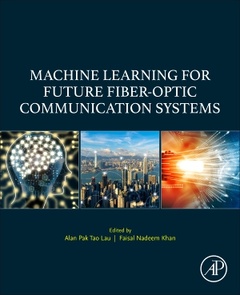Machine Learning for Future Fiber-Optic Communication Systems
Coordonnateurs : Lau Alan Pak Tao, Khan Faisal Nadeem

Machine Learning for Future Fiber-Optic Communication Systems provides a comprehensive and in-depth treatment of machine learning concepts and techniques applied to key areas within optical communications and networking, reflecting the state-of-the-art research and industrial practices. The book gives knowledge and insights into the role machine learning-based mechanisms will soon play in the future realization of intelligent optical network infrastructures that can manage and monitor themselves, diagnose and resolve problems, and provide intelligent and efficient services to the end users.
With up-to-date coverage and extensive treatment of various important topics related to machine learning for fiber-optic communication systems, this book is an invaluable reference for photonics researchers and engineers. It is also a very suitable text for graduate students interested in ML-based signal processing and networking.
2. ML techniques for long-haul systems
3. ML techniques for IM/DD systems
4. ML techniques for passive optical networks
5. ML for end-to-end learning of complete fiber-optic communication system
6. ML methods for QoT estimation and optical performance monitoring
7. ML-based adaptive network resources allocation, control and management
8. ML-assisted cognitive network fault protection and management
9. ML for cross-layer optimizations and automated network operation in SDNs
10. ML for network security management, and attacks and intrusions detection
11. ML for low-margin optical networking
12. ML for quantum optical communication systems
13. ML for intelligent testing and measurement equipment
14. ML for design and optimization of photonic devices and sub-systems
15. ML for channel coding
Faisal Nadeem Khan received the B.Sc. degree in electrical engineering (with Honours) from the University of Engineering and Technology Taxila, Pakistan, the M.Sc. degree in communications technology from the University of Ulm, Germany, and the Ph.D. degree in electronic and information engineering from The Hong Kong Polytechnic University, Hong Kong. He worked as a Senior Lecturer at the School of Electrical and Electronic Engineering of the University of Science Malaysia. He had also been a Research Fellow at the Photonics Research Centre, The Hong Kong Polytechnic University. Currently, he is an Associate Professor at Tsinghua-Berkeley Shenzhen Institute, Shenzhen International Graduate School, Tsinghua University. His research interests include machine learning and digital signal processing techniques for optical communication systems and networks. He has authored or coauthored around 60 research articles in leading journals (including several invited papers) and key conferences as well as written two book chapters. He has been an invited speaker at various prestigious international conferences including Optical Fiber Communication (OFC), European Conference on Optical Communi
- Discusses the reasons behind the recent popularity of machine learning (ML) concepts in modern optical communication networks and the why/where/how ML can play a unique role
- Presents fundamental ML techniques like artificial neural networks (ANNs), support vector machines (SVMs), K-means clustering, expectation-maximization (EM) algorithm, principal component analysis (PCA), independent component analysis (ICA), reinforcement learning, and more
- Covers advanced deep learning (DL) methods such as deep neural networks (DNNs), convolutional neural networks (CNNs), recurrent neural networks (RNNs), and generative adversarial networks (GANs)
- Individual chapters focus on ML applications in key areas of optical communications and networking
Date de parution : 02-2022
Ouvrage de 402 p.
19x23.4 cm



